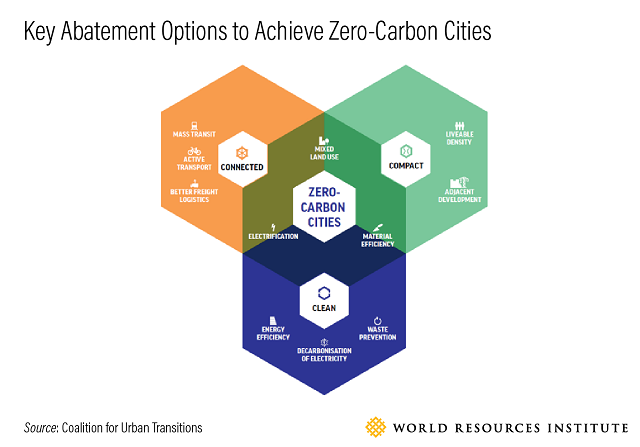
How can we transition to a low-carbon city?
Cities have a massive impact on environment, hence low-carbon cities are crucial to mitigate climate change. This transition requires us to integrate mitigation and adaptation options in multiple sectors. This is called sector-coupling approach.
How can we transition to a low-carbon city?
Cities have a massive impact on environment, hence low-carbon cities are crucial to mitigate climate change. This transition requires us to integrate mitigation and adaptation options in multiple sectors. This is called sector-coupling approach.
• Why are energy-system transitions important?
An energy-system transition could reduce carbon dioxide emissions by around 74%. This transition must be implemented both on the demand the supply side.
Mitigation options on the supply side include phasing out fossil fuels and increasing the share of renewables and using carbon capture and storage technologies. On the demand side, using the 'avoid, shift, improve' framework would require reducing the demand for energy and substituting fossil fuels with renewables.
With rapid advancements in clean energy and related technologies, only social and political barriers remain to implementing low-carbon solutions.
• What are the different strategies?
The key considerations in framing energy-transition policies are a city's spatial form, land-use pattern, level of development and state of urbanisation.
Cities, both established and emerging, can implement methods to tackle climate change. Promoting public as well as active transport like waking or cycling, electrifying public vehicles, setting up renewable-based cooling and heating networks, using energy-efficent services and infrastructure and a people-centric urban design. They can also mandate net-zero energy use, while gradually shifting to low-emssion construction material.
• Justice concerns and importance
Energy systems are directly and indirectly linked to livelihoods, local economic development, and the socio-economic well-being of people engaged in diverse sectors. Hence, energy supply needs to be balanced against fast growing energy demand, needs of energy security, and exports.
Additional justice concerns include land dispossession, marginalisation of certain communities, gendered impacts and the reliance on coal for livelihoods. Energy poverty remains a constant struggle in developing and low-income countries.
This requires a comprehensive approach, keeping the interests of multiple stakeholders into consideration. This includes a multidimensional decision-making strategy, promoting energy efficiency, scaling up investments, and including indigenous and local experiences.
